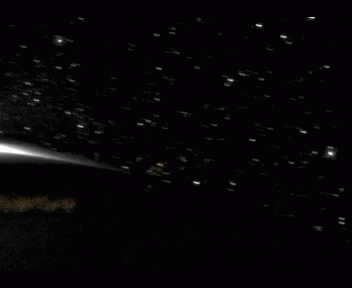English: An aurora, shining high above the northern part of Saturn, moves from the night side to the day side of the planet in this animation recorded by
Cassini. These observations, taken over four days, represent the first visible-light video of Saturn's auroras. They show tall auroral curtains, rapidly changing over time when viewed at the limb, or edge, of the planet's northern hemisphere. The sequence of images also reveals that Saturn's auroral curtains, the sheet-like formations of light-emitting atmospheric molecules, stretch up along Saturn's magnetic field and reach heights of more than 1,200 kilometres above the planet's limb. These are the tallest known “northern lights” in the solar system. These auroral displays are created by charged particles from the magnetosphere that plunge into the planet's upper
atmosphere and cause it to glow. The magnetosphere is the region of electrically charged particles that are trapped in the magnetic field of the planet. The auroral curtains shown in the animation reveal the paths that these charged particles take as they flow along lines of the magnetic field between the planet's magnetosphere and
ionosphere. The day side of Saturn scatters light toward Cassini, creating the
overexposed triangle at the centre of the left of the frame.
Stars can be seen above the limb of the planet, trailing across the field of view. The images for the animation were captured in black and white, but the aurora in the animation is shown in a false orange colour to distinguish it from background noise in the images. The images were processed to remove
cosmic ray hits, bad pixels and lens flare. On
Earth, auroras often appear green, but scientists do not yet know the colour of auroras on Saturn. Auroras on Saturn, like those on Earth, appear mostly in the high latitudes near the planet's poles. The auroras can be seen moving with the planet's rotation along the curved path of about 74 degrees north latitude. They change shape and brightness in a manner similar to terrestrial auroras. The aurora curtains become particularly bright when they are projected edge-on to Cassini as they pass over the limb from the near (dark) side to the far (bright) side of Saturn. Near the end of the animation, a
snake-shaped aurora footprint brightens abruptly and fades over about five frames.






